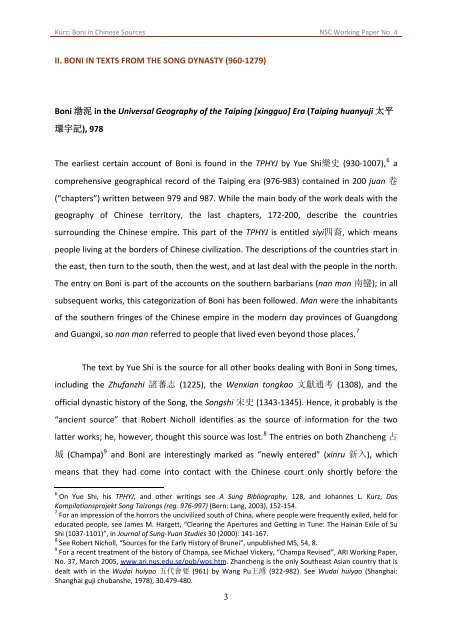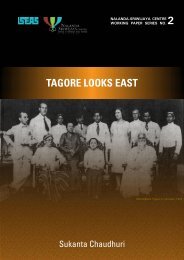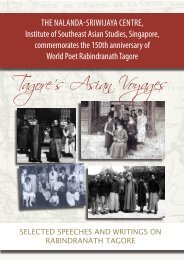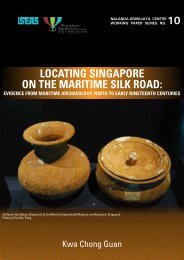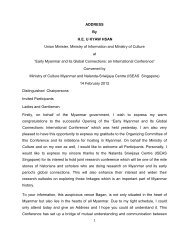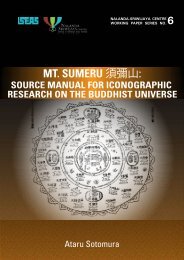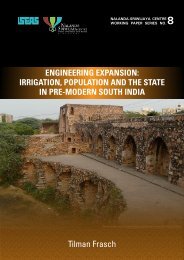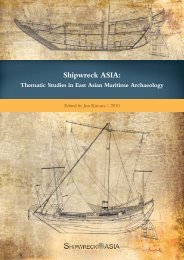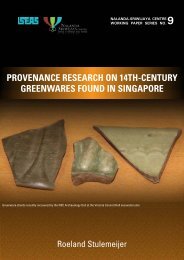Boni in Chinese Sources - Nalanda-Sriwijaya Centre - iseas
Boni in Chinese Sources - Nalanda-Sriwijaya Centre - iseas
Boni in Chinese Sources - Nalanda-Sriwijaya Centre - iseas
You also want an ePaper? Increase the reach of your titles
YUMPU automatically turns print PDFs into web optimized ePapers that Google loves.
Kurz: <strong>Boni</strong> <strong>in</strong> Ch<strong>in</strong>ese <strong>Sources</strong> NSC Work<strong>in</strong>g Paper No. 4II. BONI IN TEXTS FROM THE SONG DYNASTY (960‐1279)<strong>Boni</strong> 渤 泥 <strong>in</strong> the Universal Geography of the Taip<strong>in</strong>g [x<strong>in</strong>gguo] Era (Taip<strong>in</strong>g huanyuji 太 平環 宇 記 ), 978The earliest certa<strong>in</strong> account of <strong>Boni</strong> is found <strong>in</strong> the TPHYJ by Yue Shi 樂 史 (930‐1007), 6 acomprehensive geographical record of the Taip<strong>in</strong>g era (976‐983) conta<strong>in</strong>ed <strong>in</strong> 200 juan 卷(“chapters”) written between 979 and 987. While the ma<strong>in</strong> body of the work deals with thegeography of Ch<strong>in</strong>ese territory, the last chapters, 172‐200, describe the countriessurround<strong>in</strong>g the Ch<strong>in</strong>ese empire. This part of the TPHYJ is entitled siyi 四 裔 , which meanspeople liv<strong>in</strong>g at the borders of Ch<strong>in</strong>ese civilization. The descriptions of the countries start <strong>in</strong>the east, then turn to the south, then the west, and at last deal with the people <strong>in</strong> the north.The entry on <strong>Boni</strong> is part of the accounts on the southern barbarians (nan man 南 蠻 ); <strong>in</strong> allsubsequent works, this categorization of <strong>Boni</strong> has been followed. Man were the <strong>in</strong>habitantsof the southern fr<strong>in</strong>ges of the Ch<strong>in</strong>ese empire <strong>in</strong> the modern day prov<strong>in</strong>ces of Guangdongand Guangxi, so nan man referred to people that lived even beyond those places. 7The text by Yue Shi is the source for all other books deal<strong>in</strong>g with <strong>Boni</strong> <strong>in</strong> Song times,<strong>in</strong>clud<strong>in</strong>g the Zhufanzhi 諸 蕃 志 (1225), the Wenxian tongkao 文 獻 通 考 (1308), and theofficial dynastic history of the Song, the Songshi 宋 史 (1343‐1345). Hence, it probably is the“ancient source” that Robert Nicholl identifies as the source of <strong>in</strong>formation for the twolatter works; he, however, thought this source was lost. 8 The entries on both Zhancheng 占城 (Champa) 9 and <strong>Boni</strong> are <strong>in</strong>terest<strong>in</strong>gly marked as “newly entered” (x<strong>in</strong>ru 新 入 ), whichmeans that they had come <strong>in</strong>to contact with the Ch<strong>in</strong>ese court only shortly before the6 On Yue Shi, his TPHYJ, and other writ<strong>in</strong>gs see A Sung Bibliography, 128, and Johannes L. Kurz, DasKompilationsprojekt Song Taizongs (reg. 976‐997) (Bern: Lang, 2003), 152‐154.7 For an impression of the horrors the uncivilized south of Ch<strong>in</strong>a, where people were frequently exiled, held foreducated people, see James M. Hargett, “Clear<strong>in</strong>g the Apertures and Gett<strong>in</strong>g <strong>in</strong> Tune: The Ha<strong>in</strong>an Exile of SuShi (1037‐1101)”, <strong>in</strong> Journal of Sung‐Yuan Studies 30 (2000): 141‐167.8 See Robert Nicholl, “<strong>Sources</strong> for the Early History of Brunei”, unpublished MS, 54, 8.9 For a recent treatment of the history of Champa, see Michael Vickery, “Champa Revised”, ARI Work<strong>in</strong>g Paper,No. 37, March 2005, www.ari.nus.edu.sg/pub/wps.htm. Zhancheng is the only Southeast Asian country that isdealt with <strong>in</strong> the Wudai huiyao 五 代 會 要 (961) by Wang Pu 王 溥 (922‐982). See Wudai huiyao (Shanghai:Shanghai guji chubanshe, 1978), 30.479‐480.3


